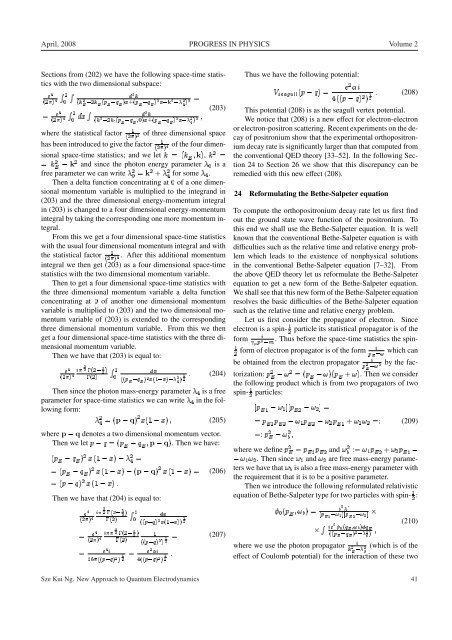Vol. 2 - The World of Mathematical Equations
Vol. 2 - The World of Mathematical Equations
Vol. 2 - The World of Mathematical Equations
Create successful ePaper yourself
Turn your PDF publications into a flip-book with our unique Google optimized e-Paper software.
April, 2008 PROGRESS IN PHYSICS <strong>Vol</strong>ume 20RSections from (202) we have the following space-time statisticswith the two dimensional subspace:e 4(2) 4R1d 3 k(kE 2 2k E (p E q E )x+(p E q E )2 x k 2 = 2 4) 2= e4(2) 4R10 dx Rd3 k(k 2 2k(p E q E ;0)x+(p E q E ) 2 x ; 2 4) 2(203)where the statistical factor 1(2) 3 <strong>of</strong> three dimensional spacehas been introduced to give the factor 1(2) 4 <strong>of</strong> the four dimensionalspace-time statistics; and we let k = (k E ; k), k 2 == k 2 E k 2 and since the photon energy parameter 0 is afree parameter we can write 2 0 = k 2 + 2 4 for some 4 .<strong>The</strong>n a delta function concentrating at 0 <strong>of</strong> a one dimensionalmomentum variable is multiplied to the integrand in(203) and the three dimensional energy-momentum integralin (203) is changed to a four dimensional energy-momentumintegral by taking the corresponding one more momentum integral.From this we get a four dimensional space-time statisticswith the usual four dimensional momentum integral and withthe statistical factor 1(2) 4 . After this additional momentumintegral we then get (203) as a four dimensional space-timestatistics with the two dimensional momentum variable.<strong>The</strong>n to get a four dimensional space-time statistics withthe three dimensional momentum variable a delta functionconcentrating at 0 <strong>of</strong> another one dimensional momentumvariable is multiplied to (203) and the two dimensional momentumvariable <strong>of</strong> (203) is extended to the correspondingthree dimensional momentum variable. From this we thenget a four dimensional space-time statistics with the three dimensionalmomentum variable.<strong>The</strong>n we have that (203) is equal to:e 4 i 3 2 (2 3(2) 4 2(2) ) R1 dx0: ((p E q E ) 2 x(1 x) 2 4) 1 (204)2<strong>The</strong>n since the photon mass-energy parameter 4 is a freeparameter for space-time statistics we can write 4 in the followingform: 2 4 = (p q) 2 x(1 x) ; (205)where pq denotes a two dimensional momentum vector.<strong>The</strong>n we let p q = (p E q E ; p q). <strong>The</strong>n we have:(p E q E ) 2 x(1 x) 2 4 == (p E q E ) 2 x(1 x) (p q) 2 x(1 x) == (p q) 2 x(1 x) :<strong>The</strong>n we have that (204) is equal to:e 4 i 3 2 (2 3(2) 4 2(2) ) R1 dx0 ((p q) 2 x(1 x)) 1 2= e4(206)i 3 2 (2 3(2) 4 2(2)) 1= (207)((p q) 2 ) 1 2 : 4((p q) 2 ) 2 1=e 4 i16((p q) 2 ) 1 2 = e 2 iThus we have the following potential:V seagull (p q) =e 2 i4((p q) 2 ) 1 2: (208)This potential (208) is as the seagull vertex potential.We notice that (208) is a new effect for electron-electronor electron-positron scattering. Recent experiments on the decay<strong>of</strong> positronium show that the experimental orthopositroniumdecay rate is significantly larger than that computed fromthe conventional QED theory [33–52]. In the following Section24 to Section 26 we show that this discrepancy can beremedied with this new effect (208).24 Reformulating the Bethe-Salpeter equationTo compute the orthopositronium decay rate let us first findout the ground state wave function <strong>of</strong> the positronium. Tothis end we shall use the Bethe-Salpeter equation. It is wellknown that the conventional Bethe-Salpeter equation is withdifficulties such as the relative time and relative energy problemwhich leads to the existence <strong>of</strong> nonphysical solutionsin the conventional Bethe-Salpeter equation [7–32]. Fromthe above QED theory let us reformulate the Bethe-Salpeterequation to get a new form <strong>of</strong> the Bethe-Salpeter equation.We shall see that this new form <strong>of</strong> the Bethe-Salpeter equationresolves the basic difficulties <strong>of</strong> the Bethe-Salpeter equationsuch as the relative time and relative energy problem.Let us first consider the propagator <strong>of</strong> electron. Sinceelectron is a spin- 2 1 particle its statistical propagator is <strong>of</strong> theform i p m . Thus before the space-time statistics the spin-12 form <strong>of</strong> electron propagator is <strong>of</strong> the form p iE ! which canibe obtained from the electron propagatorp 2 E!2 by the factorization:p 2 E ! 2 = (p E !)(p E + !). <strong>The</strong>n we considerthe following product which is from two propagators <strong>of</strong> twospin- 1 2 particles:[p E1 ! 1 ][p E2 ! 2 ] == p E1 p E2 ! 1 p E2 ! 2 p E1 + ! 1 ! 2 =:=: p 2 E ! 2 b;(209)where we define p 2 E = p E1 p E2 and ! 2 b := ! 1 p E2 + ! 2 p E1! 1 ! 2 . <strong>The</strong>n since ! 1 and ! 2 are free mass-energy parameterswe have that ! b is also a free mass-energy parameter withthe requirement that it is to be a positive parameter.<strong>The</strong>n we introduce the following reformulated relativisticequation <strong>of</strong> Bethe-Salpeter type for two particles with spin- 1 2 : 0 (p E ; ! b ) =i 2 0[p E1 ! 1 ][p E2 ! 2 ] Rie 2 0 (q E ;! b )dq E((p E q E ) 2 2 0) ; (210)where we use the photon propagator ikE2 (which is <strong>of</strong> the2 0effect <strong>of</strong> Coulomb potential) for the interaction <strong>of</strong> these twoSze Kui Ng. New Approach to Quantum Electrodynamics 41
















